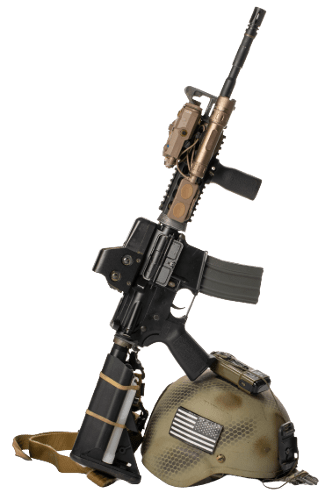Are you looking for all of the necessary rules and regulations for trap shooting? In this article, you will find all of the rules associated with trap shooting and how to understand them.
Learn Rules and Regulations by Trap Shooting Type
After you fully understood what trap shooting is, it is the time to learn all the fundamentals of this awesome sport.
Below you will find the details on what the rules are, what they mean, and why they are important for each of the four main trap shooting types.
#1 American Trap Shooting
Fundamentals
The rules of American trap shooting are very basic and easy to understand. Once you learn these fundamentals, you will begin to have an easier time understanding what is going on.
This form of trap shooting is divided into three different categories and involves a lot of movement, action, and timing.
Clay discs are thrown through the air as shooters attempt to hit them from various shooting positions. During this process, there is a simple set of rules to follow.
Rules and Regulations
As we previously mentioned, American trap shooting is broken down into three categories: singles, doubles, and handicap. Each of these follows similar rules with just some slight variations.
Targets get thrown by the trap shooting machine in the trap house. There are five different shooting stations, and each is 16 yards behind the trap house. During singles, only one target is thrown.
During doubles, however, two separate targets are thrown and competitors are shooting at five pairs (10 targets) from each shooting station. In handicap, the machine functions the same as in singles with the difference being the shooters standing farther away from the trap house.
Points are scored as targets are hit. The targets must be thrown no less than 48 yards and no more than 52 yards. They should be between 8 and 12 feet high and 10 yards from the trap house.
Shooters have to stand a minimum of 16 yards from the trap house. When the shooter is ready to shoot, he must do so at the target after yelling “pull”.
It doesn’t matter in the scoring if only a small piece of the target is hit or if it shatters completely. The target is considered “dead”.
Shooting is done in rounds of 25. Shot size can be no bigger than #7 ½, and pellets must be either lead or lead alloy and round in shape. Proper eye and ear protection must be worn at all times while shooting.
#2 Olympic Trap Shooting
Fundamentals
The basics of Olympic trap shooting are very similar to American trap shooting with a few key differences.
Learning these fundamentals will allow you to understand and compete in Olympic-style trap shooting competitions, and will overall give you the ability to improve your skills across all trap shooting forms and styles.
Rules and Regulations
The biggest difference between American trap shooting and Olympic trap shooting is the way targets are delivered.
Olympic trap utilizes 15 fixed-angle machines instead of a single oscillating machine that American trap uses. The 15 machines are designed to throw 10 left, 10 right, and 5 straight away targets in a randomized order.
There are six shooters that are assigned to each station with the sixth shooter starting at a holding station.
After the start signal, the first shooter will have 10 seconds to call for a target.
After firing, they will wait for the second shooter to finish shooting and then move to station two while the last person at station six moves to station one.
This will continue until the end of the round. Points are scored just like in American trap with points being awarded for hit targets. Each round is refereed by a person on the line behind the shooters.
#3 Double Trap Shooting
Fundamentals
Because double trap shooting is one of the newest forms of trap shooting, the rules can and have changed throughout the years.
Much like the name suggests, however, the fundamentals are there with two targets being released at the same time.
It has been an Olympic event since 1996, and the fundamentals are very similar to that of American or Olympic trap shooting.
Rules and Regulations
A complete round consists of 15 pairs, with competitions made up of shooting five rounds of random targets. This will leave a grand total of 150, plus a finalist round for the top six shooters.
Just like in Olympic trap shooting, there are six shooters on a squad that will shoot and compete together. Target setups are configured in one of three different “schemes”.
Both targets are released at the same time from either scheme A, B, or C. This means that a shooter must react to the target as it leaves the trap house, and there is a big advantage to shooting the first target as soon as possible.
As with other Olympic shooting events, participants can only use approved cartridges and shotguns for trap shooting.
In international double trap shooting competitions, the main course consists of 75 doubles for both the men’s and women’s divisions.
The men’s event, however, will involve a 25-double final for the top six as we mentioned previously.
#4 Wobble Trap Shooting
Fundamentals
The basics of wobble trap shooting are being able to hit a target that is sporadic and has a much more difficult flight path when compared to other targets.
This is why many hunters and outdoorsmen prefer this style of trap shooting as it simulates upland game hunting.
The shooter will still be 16 yards behind the trap house during competitions, and just as in regular trap shooting they must signal in order to release their target while shooting from designated shooting positions.
Rules and Regulations
While not sanctioned by the ATA like standard or American trap shooting, wobble trap shooting still holds plenty of competitions around the country as shooters love the added difficulty it brings.
It also helps with a more realistic approach for bird hunting, which many competitors also engage in. The rules are the same as American trap shooting, with just a few variations.
They will shoot from the same shooting positions, and must signal when ready. In wobble trap shooting, however, a shooter gets two shots per pull.
This helps with the added difficulty that this type of trap shooting brings. Shooters that are at stations 1 and 5 must also stand at the 18 yard mark while positions 2, 3, and 4 will stand at the 17 yard mark.
Other than that, scoring and regulations are almost identical to American trap shooting with the same systems in place.
Whether you are looking to get into trap shooting for fun or to compete, you can start simply from finding a trap shooting range near you.
That said, since it is a little more specialized shooting activity than a typical shooting, it is recommended to take a few private lessons to quicker get into the grove and start fully enjoying it.



